"How do you write about a world you haven't lived in?" 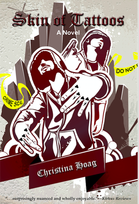 This is the question posed by my guest author, Christina Hoag, a journalist-turned-novelist as she discusses her latest thriller... From the official blurb: Los Angeles homeboy Mags is desperate to get out of gang life, but the only exit is through sacrificing everything – and everyone - he loves. He must make the difficult choice, and soon, or have it made for him. Based on extensive interviews with street gang members, this noir crime novel explores a poor immigrant family’s struggle to survive in a gritty world where gangs appear to offer youth a way out but instead ensnare them in a tangle of deceit and betrayal. Just think how boring literature would be if writers just wrote what they knew. You could basically throw out historical and science fiction, for starters, plus a whole lot else. Just how many authors, screenwriters and TV writers have been serial killers? But how do you write about a world you haven’t lived in? Write what you’re passionate about, what intrigues you, and prepare to do a lot of research. You’ll also need your novelist’s imagination, a healthy dollop of intuition to fill in the gaps, and plenty of confidence that you can pull it off. My novel “Skin of Tattoos” is about an immigrant family who leaves a war zone of guerrillas in Central America and ends up in a war zone of gangs in Central Los Angeles. Much to his family’s dismay, the protagonist Mags gets involved in a gang with some inevitable consequences, such as a prison stint. When he gets out, things really go sideways for both himself and his family. How did I delve into this foreign world? First, I should say that I was a journalist, and the idea was sparked by my interviews with former gang members in El Salvador for a magazine story. I lived in Latin America for nine years so I knew that culture pretty well and speak Spanish. Years later, when I moved to Los Angeles, I worked for The Associated Press and my urban affairs beat involved writing about inner-city neighborhoods. I remembered my idea for a novel about the trap of gang life, and was amassing knowledge. I interviewed people involved with gangs in various aspects, plus people who were directly affected by gang activity. One of those interviews led to a nonfiction book about community peacekeeping in gang neighborhoods. “Peace in the Hood: Working with Gang Members to End the Violence” involved even more interviews with experts and former gang members. As I drove around these neighborhoods as a reporter, I absorbed details like the proverbial sponge. To get more personal details about this culture, I read every memoir written by former gang members I could find. They were a fantastic firsthand source. I read books about gangs themselves, devoured news stories, watched movies and TV shows about gangs, which were great as visual and dialogue aids. I found online dictionaries of gang slang. I stopped and started the novel many times, repeatedly losing my confidence as I began to realize the depth of the venture I’d taken on. But in the end, I persisted, and I’m glad I did even though it took years to finish the project. I love that book and all the characters. Maybe I’ll even do a sequel.  Christina Hoag is a former journalist for the Miami Herald and Associated Press who’s been threatened by a murderer’s girlfriend, had her laptop searched by Colombian guerrillas and phone tapped in Venezuela, hidden under a car to evade Guatemalan soldiers, posed as a nun to get inside a Caracas jail, interviewed gang members, bank robbers, thieves and thugs in prisons, shantytowns and slums, not to forget billionaires and presidents, some of whom fall into the previous categories. Kirkus Reviews praised Christina as a “talented writer” with a “well crafted debut” in Skin of Tattoos (Martin Brown Publishing, 2016), a noir crime novel. Her thriller Girl on the Brink (Fire and Ice YA, 2016) was named to Suspense Magazine’s Best of 2016 YA list. She also writes nonfiction, co-authoring Peace in the Hood: Working with Gang Members to End the Violence (Turner Publishing, 2014), a groundbreaking book on violence intervention used in several universities. Christina makes her home in Los Angeles and lives on the web at www.christinahoag.com.
4 Comments
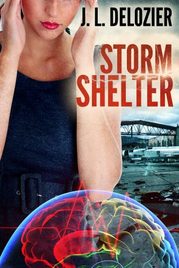 I'm delighted to host J.L. Delozier, author of thrillers TYPE AND CROSS and STORM SHELTER on my blog today. From the blurb: Dr. Persephone (Seph) Smith is a psychologist with enhanced empathy, allowing her to feel the emotions of others. But her gift comes with a price. Plagued by nightmares and insecure in her work, Seph absorbs the suffering of her patients by day and swills tequila by night. When Seph is deployed to an abandoned air hangar turned medical shelter during a massive hurricane, one by one, as the wind howls overhead, staff and evacuees disappear into the dark recesses of the vast space. The missing return as mutilated corpses. The living, trapped in the shrieking metal structure by the storm, descend into varying levels of paranoia and madness. Seph, as both counselor and detective, must determine who, or what, is preying on them. Is the panic and mayhem “shelter shock,” as the lead physician, Anne Parrish, insists? Or is everyone, Seph included, in danger of losing their minds—and their lives? Storm Shelter is a prequel to TYPE AND CROSS (WiDo Publishing, 2016) which features an older, wiser Dr. Persephone Smith. TYPE AND CROSS was recently nominated for International Thriller Writer’s “Best First Novel” of 2016. "Write what you know.” That tired, yet ubiquitous advice haunts first-time novelists and stifles the creativity of even advanced writers. Without dreamers—think Jules Verne and Arthur C. Clark—certain genres such as scifi, which relies on imaginative world-building, would be boring indeed. That said, when I committed to writing my first thriller, Type & Cross, I succumbed to the comfort of what I knew—science, medicine, and psychology. No research required, right? Wrong. As I wrote, I soon realized I’d entered Michael Crichton territory: a story built on a foundation of scientific fact, but with details so twisted and warped, I’d entered the fringes of possibility. I’d created my very own Jurassic Park, and I needed to do some research. For me, research meant digging out my old, dusty medical textbooks and boning up on hematology and virology—the study of blood and viruses, respectively. I had the added pressure of knowing my medical colleagues would be lying in wait, scalpels in hands, ready to shred my science to bits. I had to make the details genuine, but also salient and accessible to the average reader (i.e. not boring!) The science needed to drive the story, not drown it. Dr. Crichton was a master of this delicate balancing act. I was a newbie. Did I accomplish the task? You be the judge. I’ve had reviewers comment both ways. When I started book two, Storm Shelter, I swore I would make it easier on myself. No international hijinks (thank you, Google Maps.) No bizarre medical conditions. This time, I would write what I know. The end result: Storm Shelter takes place almost entirely within a single air hangar-turned-hurricane shelter in San Antonio and is based upon my real-life experiences as a disaster physician for the federal government. I’ve been in three such scenarios, and I merged the people, locations, and situations into one authentic and terrifying wild ride—no research required. Much of what you read in Storm Shelter actually happened in one form or the other (up until the grisly murders, that is!) It’s as close to a biography of those years as I’ll ever write, with details obscured to protect the innocent. Storm Shelter is available now on Kindle and releases in print on June 28th. But now I’m onto book three, the sequel to Type & Cross. And guess what? I’m in the Basque community of Spain (research) running through the medieval streets of Bilbao (research) while chasing a mad scientist who’s attempting to genetically modify people’s blood types in order to create a master race (research, research, research!) I am not writing what I know. I’d like to think Michael Crichton would approve.  J. L. Delozier spent the early part of her career as a rural family doctor and then later as a government physician, caring for America’s veterans and deploying to disasters such as Hurricanes Katrina, Ike and Gustav. Throughout it all, she quietly absorbed the sometimes fascinating, often heartbreaking and always dramatic life stories of her patients. She currently lives in Pennsylvania with her husband and four rescue cats. Learn more at her website jldelozier.com. 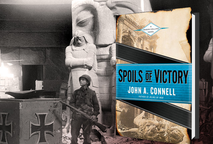 credit: http://johnaconnell.com/ credit: http://johnaconnell.com/ The Brothers Grimm meet the Nazis? I'm delighted to have John A. Connell join me on my blog today. Here, he describes how a small city in Germany served as the dramatic backdrop for SPOILS OF VICTORY, his latest crime thriller set during the post-World War II era. The dark layered history of this small city is truly fascinating... 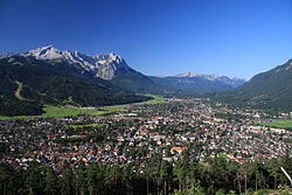 Garmisch-Partenkirchen Garmisch-Partenkirchen Garmisch-Partenkirchen would seem like an unlikely place to set SPOILS OF VICTORY, my latest crime thriller about murder and organized crime in post-WW2 Germany. The small German city—or large town, depending on how you look at it—could have been the setting for a fairytale in some far-off land. Nestled in a valley of the Bavarian Alps, its streets are graced with Hansel-and-Gretel houses and buildings with frescoes of pastoral scenes or local saints. Partenkirchen, first mentioned in 15A.D., was originally a Roman settlement, and one of its main streets still follows the old Roman trade route between Venice and Augsburg. Garmisch was settled 800 years later by a Germanic tribe. Separated by the glacier-fed Partnach river, the two towns remained separate until Hitler forced them to unite in 1935. Garmisch (as it is commonly called—much to the chagrin of the people of Partenkirchen) has been a favored winter resort since the late 1800s. The highest mountain in Germany is there, and the entire region is crisscrossed by world-famous ski slopes and dotted with placid alpine lakes. Hardly a promising location for murder and mayhem. 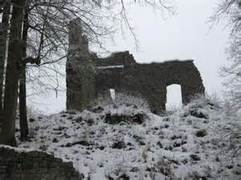 Werdenfels Castle...haunted? Werdenfels Castle...haunted? On the surface, that is, as Garmisch-Partenkirchen has had several dark periods. The first came in the 1600s, when the importance of overland trade routes dried up, causing Garmisch-Partenkirchen to come to near ruin. Privation, plagues, and crops failures led to witch-hunts, and in one two-year period 10% of the meager population was burned at the stake or garroted. Legend has it that Werdenfels castle, where the “witches” were imprisoned and executed, was so haunted that it was abandoned and torn down to build a church to drive away the evil that lurked within its walls. An even darker period descended on Garmisch with the Nazis’ rise to power. Göring went there to be treated for a bullet wound after Hitler’s failed putsch and given honorary citizen status by the city’s leaders. Hitler had wanted to buy farmland there for his mountain retreat, but the farmer wouldn’t sell, and Adolf ended up building his Eagle’s Nest in Berchtesgaden; a veritable who’s who of Nazis had called Garmisch their home away from home. The vestiges of the 1936 Winter Olympics still stand as monuments to Hitler’s dream of a 1000-year empire, though gone are the Nazi banners and signs forbidding Jews, or the elite Gebirgsjäger soldiers and swastika flag-waving fanatics. Indeed, it was a past so sordid that the town only commissioned it's archives in 1972—the people had no interest in remembering their Nazi past. 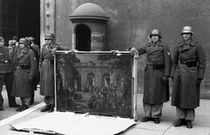 German soldiers of the Hermann Göring Division posing in front of Palazzo Venezia in Rome in 1944 German soldiers of the Hermann Göring Division posing in front of Palazzo Venezia in Rome in 1944 So, why did I decide on Garmisch-Partenkirchen for murder and mayhem? It was really by serendipity. My protagonist, Mason Collins, was actually the villain in a previous, defunct novel, with him committing murder in order to steal a cache of Nazi gold in occupied Germany. It was when I began researching Mason’s murderous backstory that I discovered that after WW2 the charming and beautiful Garmisch-Partenkirchen had become the Dodge City of occupied Germany! When the Third Reich collapsed, and the Allied armies were pushing into Germany from the west and east, Garmisch-Partenkirchen became the stem of the funnel for fleeing wealthy Germans, Nazi government officials and war criminals, retreating SS, and former French Vichy and Mussolini officials. And for the same reason it also became the final destination for Nazi-stolen art masterpieces, vast reserves of the Third Reich gold, currencies, precious gems, penicillin, diamonds, uranium from the failed atomic bomb experiments. After the war, all that became available for purchase on the black market. With millions of dollars to be made, murder, extortion, bribes and corruption became the norm. The promise of fortunes also brought in a multitude of scoundrels, scam artists, and gangsters. Add to this, tens of thousands of bored US Army soldiers ripe for temptation. The black market thrived, and gangs of deserted allied soldiers, former POWs, ex-Nazis, and corrupt displaced persons roamed the countryside. With the U.S. officials looking the other way or profiting from the activity, some gangs operated so openly that they were more like import-export companies. Here was this fantastic contrast: a Brothers Grimm fairytale town behind whose charming facades lurked mayhem and murder. It is said that truth is stranger than fiction, and, in this case, it has proved true. I even left some of the crazier stories out just to make seem more “real!” So, as it turns out, Garmisch-Partenkirchen was a great setting for a historical crime thriller after all! 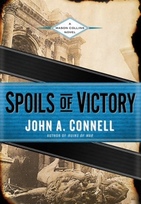 From the official blurb: From the author of Ruins of War comes an electrifying novel featuring U.S. Army criminal investigator Mason Collins, set in the chaos of post-World War II Germany. When the Third Reich collapsed, the small town Garmisch-Partenkirchen became the home of fleeing war criminals, making it the final depository for the Nazis’ stolen riches. There are fortunes to be made on the black market. Murder, extortion, and corruption have become the norm. It’s a perfect storm for a criminal investigator like Mason Collins, who must investigate a shadowy labyrinth of co-conspirators including former SS and Gestapo officers, U.S. Army OSS officers, and liberated Polish POWs. As both witnesses and evidence begin disappearing, it becomes obvious that someone on high is pulling strings to stifle the investigation—and that Mason must feel his way in the darkness if he is going to find out who in town has the most to gain—and the most to lose… 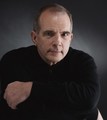 John A. Connell is the author of Ruins of War and SPOILS OF VICTORY, the first two books in the Mason Collins series. He was born in Atlanta, where he earned a BA in Anthropology, and has been a jazz pianist, a stock boy in a brassiere factory, a machinist, repairer of newspaper racks, and a printing-press operator. He has worked as a cameraman on films such as Jurassic Park and Thelma & Louise and on TV shows including The Practice and NYPD Blue. He now lives with his wife in Madrid, Spain, where he is at work on his third Mason Collins novel. Visit him online at johnconnellauthor.com. There is a long tradition of authors using pseudonyms or writing under Anonymous, and I'm always curious about what makes someone wish to write under someone else's name. I asked Sharon Pisacreta to join me on my blog today, to discuss why she uses pseudonyms (FOUR!) and how she chose them. Her first book in a new series, DYING FOR STRAWBERRIES, will be released November 1, 2016. 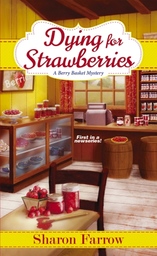 Along with spies and people in the witness protection program, authors often feel compelled to change identities. My upcoming mystery series will be released under ‘Sharon Farrow’. It will be the fourth name I’ve used as an author. When my stories and articles first began to appear in magazines, I proudly used the name I was born with. Although it was a tricky Italian name that few non-Italians could pronounce, it made my family happy. However I learned that Shakespeare’s question “What’s in a name?” has special meaning for authors. After I sold my first novel, I thought I’d make things easier for my readers and decided on ‘Sharon Kirk’ as a pseudonym (yes, I’m a Trekkie). Unfortunately, someone in production forgot to read my contract and released that first book under my Italian name. Two other books followed, accompanied by numerous calls from my publisher asking how to pronounce ‘Pisacreta’. Sales reps ran into problems with my name when speaking with distributors. One of my novels was sold as part of a six-book package on the Home Shopping Network, eliciting more questions on exactly how the TV host should say my name. My editor finally asked if I would mind taking a pseudonym. I was happy to oblige. This time I went with ‘Cynthia Kirk’. It sounded British, elegant, and impossible to mispronounce. Soon after, I put aside novel writing and returned to magazine work under my maiden name. I got back in the novel writing game when a friend and fellow author convinced me to team up with her on a mystery series. Because our previous novels were in the romance and western genres, we needed a pen name for our historical mystery series. Marketing is everything in publishing, and an author’s name is a form of branding. If readers want to buy your mystery novel, they don’t want to be confused if you also write science fiction under the same name. We wanted an easy name to spell and remember. The result was D.E. Ireland. Since our series is based on Shaw’s Pygmalion and stars Eliza Doolittle, we chose her initials, transposing them for our first name. Ireland was selected because George Bernard Shaw was born and raised in Dublin. As a writing team, a pen name seemed necessary. Few teams publish under one of the pair’s real name. A notable exception is the Ian Rutledge mystery series by Charles Todd, written by Charles and his mother Caroline. Normally, a new pseudonym is created for the duo, such as Alice Alfonsi and husband Marc Cerasino who write as ‘Cleo Coyle’. All writers should keep a few pen names in their back pocket. If you’re prolific, publishers don’t want to flood the market with too any books under one name in the same year. Because Dean Koontz sometimes published eight books a year, he wrote under eleven different names. Famous authors may feel constrained by their success and want to try something new under a pseudonym. J.K. Rowling writes mystery novels as Robert Galbraith, Stephen King’s alter ego is Richard Bachman. When Anne Rice switched from vampires to erotica, she did so under two pen names. And prolific romance author Nora Roberts chose to write as J.D. Robb for her futuristic mysteries. Because mysteries are so popular, many authors meet demand by writing more than one series under different names. Vicki Delaney writes cozies and suspense novels under both the pseudonym Eva Gates and her own name. Eva K. Sandstrom uses the pseudonym JoAnna Carl for her long running Chocoholic series. Some authors simply prefer using a pseudonym. Janet Quin-Harkin became Rhys Bowen. Juliet Marion Hulme writes as Anne Perry. As we did with D.E. Ireland, choosing a gender neutral pen name also helps attract male readers not prone to buying novels by women. Famous examples include Marion McChesney Gibbons writing as M.C. Beaton, and Edith Mary Pargeter as Ellis Peters. A publisher might also insist on a pseudonym if books written under a previous name had lackluster sales. They often feel it is best to start fresh with a new writing identity. Whether it’s due to a difficult name to pronounce, being too prolific, a poor sales record, switching genres, a writing collaboration, or a desire to conceal your gender, taking on a pseudonym is always an adventure. Finally, writing under a pen name provides a measure of anonymity – and a bit of welcome distance. A bad review directed at books written under your real name cuts a little sharper than one aimed at one written under a pseudonym. It may sound odd, but it’s true. That alone may be worth a name change. 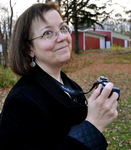 Sharon Farrow writes The Berry Basket Mysteries set in Oriole Point, Michigan. The first book in the series, DYING FOR STRAWBERRIES, will be released on November 1, 2016. While this is her debut as ‘Sharon Farrow’, she wrote romance novels under both ‘Sharon Pisacreta’ and ‘Cynthia Kirk’. In 2013, she took on another pseudonym as one half of the writing duo, ‘D.E. Ireland’, the Agatha Award nominated authors of the Eliza Doolittle/Henry Higgins mystery series. I'm joined on my blog today by Amy Shojai, author of the recently released Show and Tell. Because Amy is an expert on pet care and animal behavior and writes dog-viewpoint thrillers, I asked her to speak about what she had learned about writing pets into fiction. 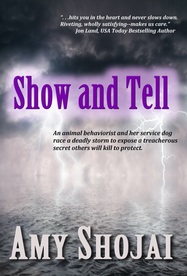 I love reading stories that incorporate animals in a believable fashion, but far too many authors insert pet characters for the wrong reason—or fail to execute in a believable fashion. Reading fiction is all about a suspension of disbelief, and a large percentage of avid readers also love pets. About 65 percent of US Households have a pet—that’s a lot of potential book buyers! The trick, of course, is making your “talking cat” or “thinking dog” so natural that readers accept this ability as fact within your story world. The really avid pet parents already have opinions and insight into how cats and dogs act, and aren’t forgiving of missed paw-steps. PETS AS PROPS. Writers often give the hero a pet to make them more likable, or they’ll have the villain kill an animal to illustrate an unsympathetic character. Most pet-loving readers object to critter-killing simply for shock value. When pets appear in the first chapter and last, with no mention in between, pet lovers recognize this as artificial manipulation. When your hero’s call to action leaves the cat/dog alone at home for weeks, readers wonder why the house isn’t full of crappiocca and hissed-off pets when s/he returns. Please, for the love of doG (and cat), create a character’s relationship with the pet, which builds character depth and reader engagement. TALKING PETS. How your animal characters interact with the humans depends a great deal on the genre and what readers expect. Fantasy’s shape-shifters certainly may have all kinds of critters thinking and speaking the same as the human characters, and many children’s books use anthropomorphized characters to advantage. Based on your story, genre, and reader expectations, decide whether your animals will be “humans in fur coats” or true to their species. Mysteries today are full of talking dogs and cats, and the successful series make clear that these critters have both species-appropriate “extra” skills and limitations. In my September Day series, service dog Shadow has his own viewpoint chapters. He never says a word, yet speaks volumes. GOALS & REWARDS. When creating an animal viewpoint character, go beyond the gift of speech or tail semaphore. Just as your hero and villain require opposing story goals and motivations to fuel the plot, give your pet character reasons to care. Shadow’s story goal and motivation is quite different than his human partner September, and he’s able to offer an enriched reader experience through his enhanced senses. Because of my background as a certified animal behavior consultant, I wanted Shadow to act and react, communicate and feel emotion in a true reflection of the canine species I know (with a bit of fiction speculation). For me, that’s not just a plot device but shows respect for these unique creatures. Shadow has his own character arc in each book. He is not the same clueless nine-month-old puppy that began the series, and has grown and developed alongside his human partner September with each new story. One caution: when writing a series, be aware of the timeline, because pets age much more quickly than human characters. I don’t what Shadow to “age out” of the series too quickly, so the first book LOST AND FOUND happens at Thanksgiving, the second one HIDE AND SEEK follows at Christmas, and now SHOW AND TELL takes place right after Valentine’s Day. Today, pets are considered to be members of the family, in some cases surrogate children. People read for entertainment, for the spills and thrills and tug-at-the-heart rooting for the underdog human—or pet. So adding a furry character to a book, when done well, enhances the reader experiences and gives everyone an extra emotional tug. September and Shadow have just begun their life together, and have many more adventures to come!  Amy Shojai is a nationally known authority on pet care and behavior, a certified animal behavior consultant, a spokesperson for the pet products industry, and the author of 30+ nonfiction pet books. She also writes THRILLERS WITH BITE! which includes the dog-viewpoint thrillers LOST AND FOUND, HIDE AND SEEK, and SHOW AND TELL. Amy can be found on Facebook http://www.facebook.com/amyshojai.cabc, on Twitter @amyshojai, and on Pinterest @amyshojai. Check out her website at http://www.shojai.com. I'm always interested in the process of world-building. While world-building is important for any story, I think that it is even more critical when writers are creating an unfamiliar world for their readers. So, for example, my books are set in 17th century England, during the time of the plague and the Great Fire of London (check out my countdown to the right!!!). While many people know about the Tudor England or the Regency period, the 1660s are a far less familiar period. So, I spend a lot of time thinking about larger cultural, social, political and gender trends that helped define my world, as well as norms, conventions and features of the period. But I think world-building is also important for those setting their books in the future, by nature an undefined period. So I invited author H.A. Raynes onto my blog today to talk about how she went about conceiving and building the future for her debut novel, NATION OF ENEMIES.  Nation of Enemies is set in the near future world of 2032 in the United States. People ask me why that year, in particular, and how did I go about creating that future world? First, the choice to set the story in 2032. Integral to the plot is a presidential election, so that was key in determining the year. Next, and importantly, I wanted it to be near enough that we can almost feel it...imagine it. It’s in our lifetime, depending on our age. I didn’t want to get caught up in the technological advances which would put Nation of Enemies more in the sci-fi realm, which would make it a different book entirely. And so then came the research. In this world I built, the United States is war-torn, like any war-torn country, wrecked by attacks, non-functioning in many ways. People have left the cities, which are easy targets, and fled either to the countryside or else attempt to emigrate to safer shores. They’re less concerned with technology and comfort and more concerned about the safety of their families. As the economy fails, government spending goes toward fighting the war and maintaining hospitals that are on the front line. A doctor is one of my protagonists and for his point of view, I researched the future of medicine. Genetics, equipment, medicine. How a hospital might function with advances in these areas. I interviewed a friend who is a doctor and used the internet at length. Of course, there’s reality and predictions of what will be in the future. I combined those elements with my imagination. I also combined them with the politics of war when I introduced the legislation of the MedID biochip citizens are forced to wear in 2032. There is an actual biochip in use today, though it is quite simple in comparison to my MedID and how it’s been manipulated by the U.S. government. There’s freedom in creating a future world. I also considered schools - what would happen if schools became even more of a target than they are today? (Though just this week, several schools in my state of Massachusetts had bomb threats.) Knowing that parents are vulnerable, I imagined terrorists using schools to, well, terrorize society on a whole new, emotional level. That forced me to bring all schools online in 2032. Kids attend class virtually, creating a safer but less social educational experience. But children suffer in this way, locked in their bedroom away from friends and situations that foster personal growth. Finally, I researched the future of the internet, the language used by experts in the field, and the hackers who exist in a darker but very real realm. It was both fascinating and frightening to discover the skills of these hackers and how they challenge governments and corporations on a daily basis for their own agendas. To “futurize” my novel, though I used terminology hackers currently use along with society’s (and government’s) fears about their power, I simply ushered them down the path. As firewalls and encryptions become more sophisticated, so do hackers. Already we are experiencing hacks into financial institutions and government agencies - I found it easy to imagine an even more widespread problem, especially when the country is distracted by war. I don’t want to spoil any plot points in Nation of Enemies, but recently there was an aspect of the Paris Attacks that included an element I used (researched and pushed farther) in terrorist communications. It sent a chill up my spine. My near-future world of 2032 is not one in which I want to live. I’m a hopeful, positive person and I have great hopes for the futures of my children. Sadly, it wasn’t difficult and in fact was quite plausible to imagine the darker side of humanity emerging with the state of the world we live in today. Let’s hope my imagination does not win out. Doesn't this book sound great?! Here's the official blurb: 2032. Turned away by London Immigration because of his family’s inferior DNA, Dr. Cole Fitzgerald returns to work at Boston’s Mass General hospital. He purchases ballistics skins for family, a bulletproof car and a house in a Safe District. As the War at Home escalates, Cole begins an underground revolution to restore civil liberties and wipe away the inequity of biology. Along the way he’ll risk his family, his career and his life when he discovers the U.S. government may pose a greater threat than the terrorists themselves.  H.A. Raynes was inspired to write NATION OF ENEMIES by a family member who was a Titanic survivor and another who escaped Poland in World War II. Combining lessons from the past with a healthy fear of the modern landscape, this novel was born. A longtime member of Boston’s writing community, she was a finalist in the Massachusetts Screenwriting Competition and has published a short story in the online magazine REDIVIDER. H.A. Raynes has a history of trying anything once (acting, diving out of a plane, white water rafting, and parenting). Writing and raising children seem to have stuck. |
Susanna CalkinsHistorian. Mystery writer. Researcher. Teacher. Occasional blogger. Categories
All
Archives
May 2023
|
 RSS Feed
RSS Feed